AUDI A4 AVANT 2008 Owners Manual
Manufacturer: AUDI, Model Year: 2008, Model line: A4 AVANT, Model: AUDI A4 AVANT 2008Pages: 368, PDF Size: 46.19 MB
Page 241 of 368
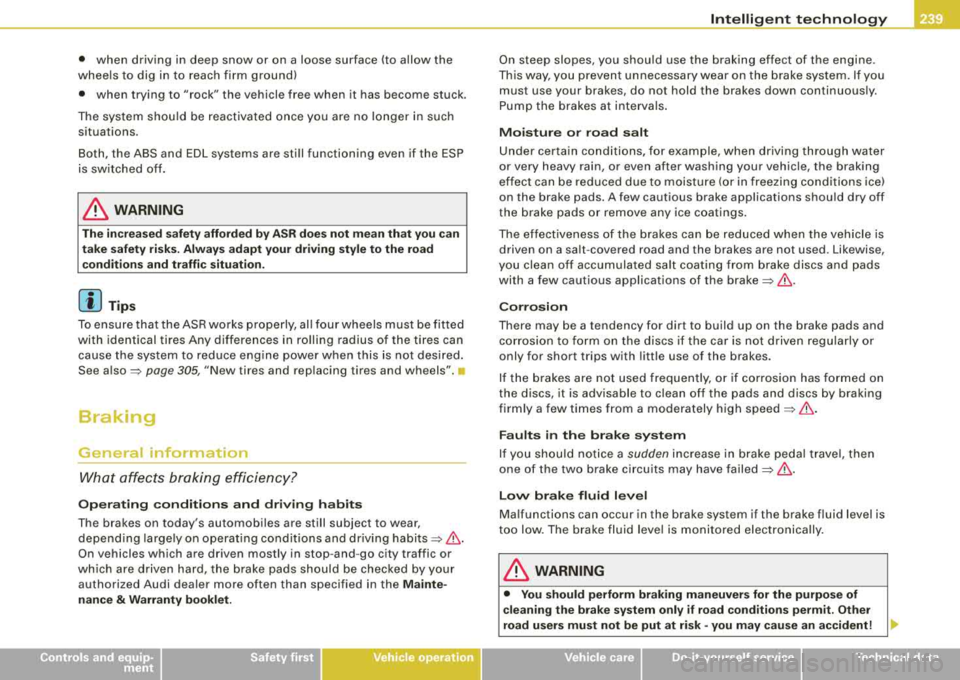
____________________________________________ ln_t_ e_ l_ li _,..g "- e_ n
_ t_t_e _c_ h_ n_o _l_o _....g ,_,y'-----'""
• when driving in deep snow or on a loose surface (to allow the
wheels to dig in to reach firm ground)
• when trying to "rock" the vehicle free when it has become stuck .
The system should be reactivated once you are no longer in such
situations.
Both, the ABS and EDL systems are still functioning even if the ESP
is switched off.
& WARNING
The increased safety afforded by ASR does not mean that you can
take safety risks. Always adapt your driving style to the road conditions and traffic situation.
[ i] Tips
To ensure that the ASR works properly, all four wheels must be fitted
with identical tires Any differences in rolling radius of the tires can
cause the system to reduce engine power when this is not desired.
See
also::::;, page 305, "New tires and replacing tires and wheels". •
Braking
General information
What affects braking efficiency?
Operating conditions and driving habits
The brakes on today's automobiles are still subject to wear,
depending largely on operating conditions and driving
habits::::;, &.
On vehicles which are driven mostly in stop -and -go city traffic or
which are driven hard, the brake pads should be checked by your
authorized Audi dealer more often than specified in the
Mainte
nance
& Warranty booklet.
Controls and equip ment Safety first Vehicle operation
On steep slopes, you should use the braking effect of the engine
.
This way, you prevent unnecessary wear on the brake system. If you
must use your brakes, do not hold the brakes down continuously.
Pump the brakes at intervals.
Moisture or road salt
Under certain conditions, for example, when driving through water
or very heavy rain, or even after washing your vehicle, the braking
effect can be reduced due to moisture (or in freezing conditions ice)
on the brake pads. A few cautious brake applications should dry off
the brake pads or remove any ice coatings.
The effectiveness of the brakes can be reduced when the vehicle is
driven on a salt -covered road and the brakes are not used. Likewise,
you clean off accumulated salt coating from brake discs and pads
with a few cautious applications of the
brake::::;, &.
Corrosion
There may be a tendency for dirt to build up on the brake pads and
corrosion to form on the discs if the car is not driven regularly or
only for short trips with little use of the brakes .
If the brakes are not used frequently, or if corrosion has formed on
the discs , it is advisable to clean off the pads and discs by braking
firmly a few times from a moderately high
speed ::::;,& .
Faults in the brake system
If you should notice a sudden increase in brake pedal travel, then
one of the two brake circuits may have
failed::::;, &.
Low brake fluid level
Malfunctions can occur in the brake system if the brake fluid level is
too low. The brake fluid level is monitored electronically.
& WARNING
• You should perform braking maneuvers for the purpose of
cleaning the brake system only if road conditions permit. Other
road users must not be put at risk - you may cause an accident!
.,.
Vehicle care Do-it-yourself service Technical data
Page 242 of 368

llffl.___l_n _t _e _ll _ig =- e_n _ t_ te_ c_h _n_ o_ lo-'g'"'-=- y ___________________________________________ _
&, WARNING (continued )
• Before des cending a steep grade , reduce speed and shift trans
mi ssion into a lo wer gear or lower driving po sition . Do not ride the
brake s or hold the pedal down too long or too often . This could
cau se the brake s to get hot and dimini sh braking efficiency .
• Do not ride the brakes by resting your foot on the ped al when
you do not intend to brake. This may cause the brakes to overheat, premature wear and in creased stopping distan ce.
• Under certain climati c and operating conditions such a s
passing through water, driving in heavy rain or after washing the
v ehicle , the effectiveness of the brakes can be reduced . In winter ,
ice can a ccumulate on the brake pads , linings , discs and drums .
Cautiously apply brakes for a te st. Brakes will dry and ice coating s
will be cleaned off after a few cautious brake applicat ions .
• Driving for an extended period of time on salt-co vered roads
without using your brakes can also affect braking effi ciency . Clean
off accumulated salt coating from brake discs and pads with a few
c autious brake appli cations .
• If you damage the front spoiler , or if you install a different
spoiler , be sure the air flow to the front brakes is not obstructed .
Otherwise the brake system could overheat reducing the effective
ness of the entire brake system .
• Failure of one brake circuit will impair the braking capability
resulting in an increased stopping distance . Avo id driving the
vehicle and have it towed to the nearest Audi dealer or qualified
workshop .•
Brake booster
T he brake booster add s ex tra braking power.
The bra ke booster works wit h vacuum pressure which is created
only whe n th e e ng in e is
runn ing=> &,.
& WARNING
• Never let the vehi cle roll to a stop with the engine shut off .
• If the brake booster is not working , for example when towing
your vehicle , or because the brake booster has somehow been
damaged, the brake pedal must be pre ssed considerably harder to
make up for the lack of booster assistance . •
Functioning of Anti-Lock Brake System (ABS)
A BS preven ts th e wh eels fr om lock ing up und er b rak ing.
T he ABS contributes effectively to vehicle contro l since it prevents
th e w heels from
lo cki ng w he n t he brakes a re a ppli ed. T h is mea ns
that the vehicle remains steerable and is less likely to skid.
With ABS you do not need to pump the brake . Just hold the brake
pedal down .
However, do not expect that the ABS shortens braking distance
u nder all circum sta nces. Whe n driving o n gravel or on newly fa lle n
snow on top of icy surfaces, braking distance may be even longer,
t herefore, under these ci rcums tances, it is espec ial ly i mpo rtant th at
you driv e slowly and with great care.
How the ABS system works
An automatic check is made when a speed of about 4 mph (6 km/h)
i s r eac hed . Wh en th is happe ns, a pumpi ng noi se can be hea rd.
I f a n indiv idual wheel be gins to rotat e too slowly i n relation to
vehic le speed and tends to lock, the ABS automatical ly reduces
brake pressur e to prevent tha t whee l from loc king .
Th is a utomatic adjustment process wi ll cause a
slight vibration of
t he brake peda l a nd s om e noi ses t o a lert y ou th at ve hicle spee d
must be adapted to existing road and traffic conditions. _..
Page 243 of 368

____________________________________________ ln_t_ e_ l_ li _,..g "- e_ n
_ t_t_e _c_ h_ n_o _l_o _....g ,_,y'-----'IJIII
& WARNING
Although the ABS is very effective, always remember that braking
capability is limited by tire traction. Always adjust your driving
speed according to the road and traffic conditions. Do not let the
extra safety afforded by the ABS tempt you into taking extra risks.
The ABS cannot overcome the laws of physics.
[ i] Tips
• If ABS is not functioning properly, a warning light will come on.
See~ page 21.
• If a fault occurs in the ABS , the EDL is also not functioning. This
is indicated by the ABS warning light. •
Brake assistant
The brake assistant is designed to achieve the optimum
braking effect.
The brake assistant helps to increase the effective braking power
and thus to achieve a shorter stopping distance . If the driver
presses the brake pedal very quickly, the brake assistant automati
cally boosts the braking force to the maximum level, up to the point
where the anti-lock brake function (ABS) intervenes to stop the
wheels from locking. You should then keep the brake pedal pressed
until the vehicle has braked to the required speed. The brake assis
tant switches itself off as soon as you release the brake pedal.
The brake assistant will not be operative if there is a malfunction in
the ABS.
Controls and equip
ment Safety first
Vehicle operation
& WARNING
Please remember that the accident risk always increases if you
drive too fast, especially in corners or on a slippery road, or if you
follow the vehicle ahead of you too closely. An increased accident
risk cannot be compensated even by the brake assistant, so
always maintain a safe speed. •
Servotronic® -advanced power
steering system
The power steering systems uses the power of the
running engine to allow precise steering with little effort. Your Audi is equipped with the electronically controlled
Servotronic® advanced power steering system. It adjusts
the degree of steering assistance to the roadspeed.
The advanced Servotronic ® power steering system senses the road
speed and electronically adjusts power assistance to provide
comfortable and safe steering response exactly matched to the
vehicle speed .
Power steering will not work if the engine is off. As a result, the
steering wheel will be hard to turn.
The power steering fluid level is checked during the scheduled
maintenance services.
0 Note
If there is an electronic malfunction, servotronic will still function
like a conventional power steering system, providing a constant
steering support force that is no longer proportionate to the vehicle
speed . This is most noticeable when turning the steering wheel at
low speeds (for example when parking), -more effort will be
required than usual.
.,.
Vehicle care Do-it-yourself service Technical data
Page 244 of 368
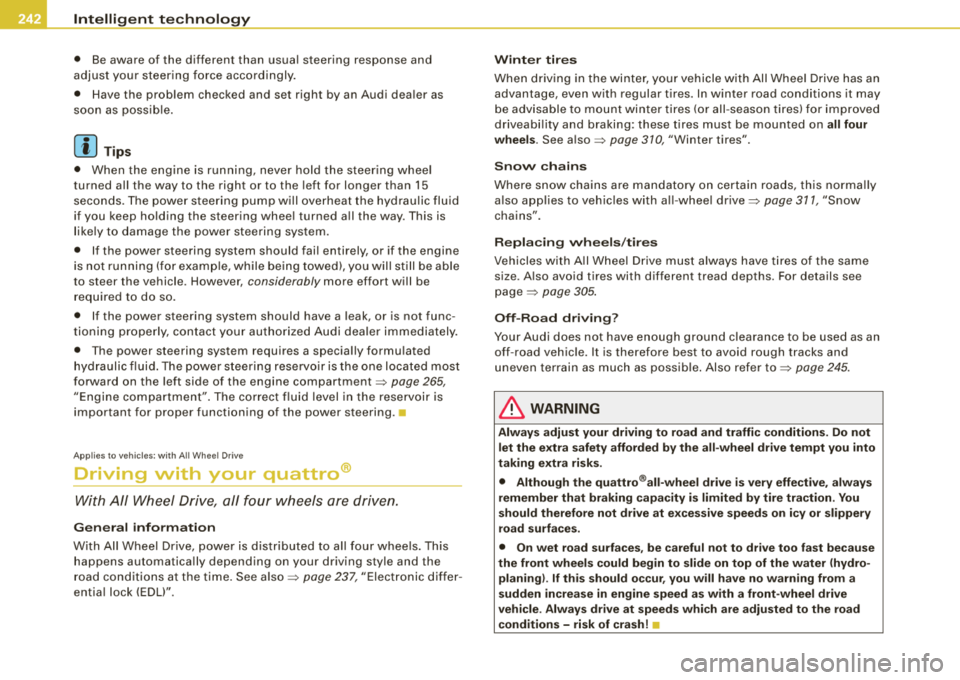
llffll.___l_n _t _e _ll _ig =- e_n _ t_ te_ c_h _n_ o_ lo-'g'"'-=- y ___________________________________________ _
• Be aware of the different than usua l steering response and
adjus t you r steer ing forc e acc ordin gly.
• Have the prob lem checked and set right by an Audi dea ler as
s o on as poss ible.
[ i] Tips
• When t he engi ne is running, never ho ld t he steer ing w heel
turned all the way to the right or to the left for longer than 15
seco nds. Th e powe r steering p ump w ill ove rhea t th e hydra ulic flu id
if you keep holding the steer ing whee l turned a ll the way . T his is
l ike ly to d amage t he powe r stee ring sys tem.
• I f the power steering system should fail entirely, or if the engine
i s not r unning ( for e xa mpl e, while being t owed), you will still be able
to steer the vehicle . However,
considerably more effort wil l be
r e q uired to do s o.
• I f the power steering system should have a lea k, or is not func
t ioning pr operly, co nt ac t yo ur auth orize d Audi deale r immedia tely.
• T he power steering system requires a specia lly formu lated
h ydraulic fluid. T he power s teeri ng reserv oir is th e one loca ted m ost
forward on the left side of the engine
compartment=> page 265,
"Engine co mpartme nt". The c orrect f luid level in the reservoir is
important for proper functioning of the power steering .•
Ap plies to veh icl es : w ith A ll Whee l Dr ive
Driving with your quattro®
Wit h All Whe el Dr ive, all fo ur w heel s are d riven .
Gen eral information
With All W heel Dr ive, powe r is d istributed to all four w hee ls . T hi s
happens automatica lly depending on your dr iving style and the
r oa d c ondit ions at th e time. See
also => page 237, "Elec tronic diff er
entia l lock (E DU" .
Winter tires
When driv ing in th e win te r, yo ur ve hicle with All Wheel Drive ha s an
advantage, even with regular t ires. In winter road conditions it may
b e advi sable to m ount win ter tires ( or all -s easo n tires) for impr oved
driveabi lit y and braking : th ese tires mus t be moun ted on
all four
wheels .
See also => page 31 0, "Winter tires".
Snow chains
Whe re snow cha ins a re ma ndato ry on certai n roa ds, th is norma lly
a lso app lies to veh ic les with a ll-wheel
dr ive=> page 311, "Snow
chain s".
Replacing wheels /tires
Ve hicles wit h All Wheel D rive mu st always have t ires of the sa me
size . A lso avo id tires with different tread depths . For details see
page
=> page 305 .
Off-Road dri ving?
Yo ur Au di d oes not have e nough gr ound clea ra nce to be use d as an
off -road vehic le . It is therefore best to avoid rough tracks and
u neven te rr ain as much as poss ible . Also refe r
to => page 2 45.
& WARNING
Alway s adjust your driving to road and traffic condition s. Do not
let the extra safety afforded by the all -wheel drive tempt you into
taking extra risks .
• Although the quattro ®all-wheel drive is very effective, always
remember that braking capacity is limited by tire traction. You
should therefore not drive at e xcessive speeds on icy or slippery
road surfaces.
• On wet road surfaces , be careful not to drive too fast be cause
the front wheels could begin to slide on top of the water (hydro
planing ). If this should occur , you will have no warning from a
sudden increase in engine speed as with a front -wheel drive
vehicle . Always drive at speeds which are adjusted to the road
conditions - risk of crash! •
Page 245 of 368
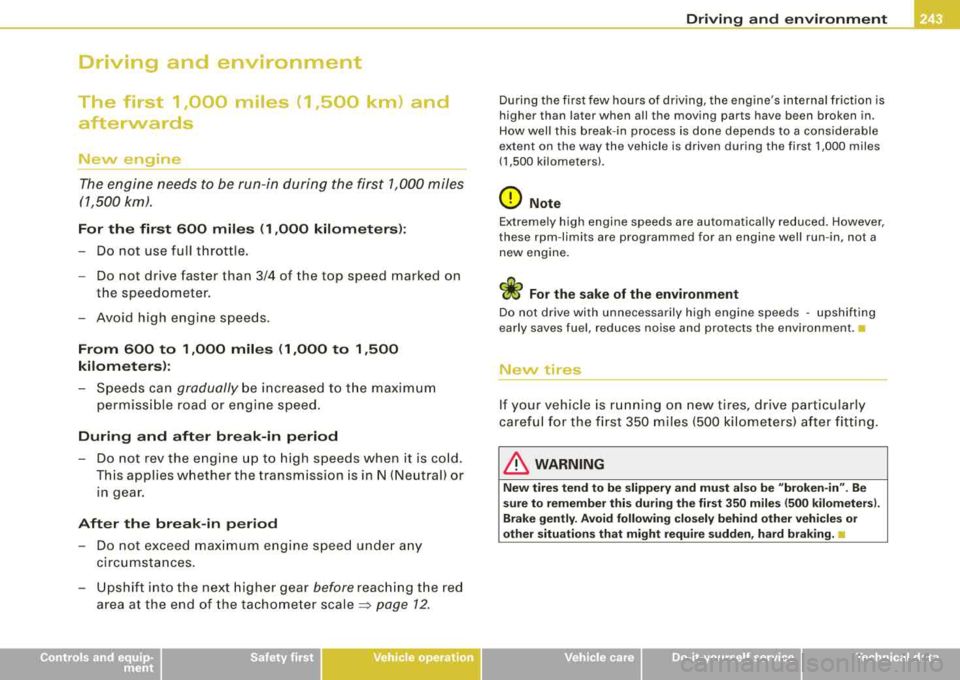
______________________________________________ D_ ri_v _ i_ n _, g..,_ a_ n_d _ e_ n_ v_i_ro _ n_m_ e_ n_t _____ ffllll
Driving and environment
The first 1,000 miles (1,500 km) and
afterwards
New engine
The engine needs to be run-in during the first 1,000 miles
(1,500 km).
For the first 600 miles (1,000 kilometers):
Do not use full throttle.
- Do not drive faster than 3/4 of the top speed marked on
the speedometer.
- Avoid high engine speeds .
From 600 to 1,000 miles (1,000 to 1,500
kilometers):
- Speeds can gradually be increased to the maximum
permissible road or engine speed.
During and after break-in period
- Do not rev the engine up to high speeds when it is cold.
This applies whether the transmission is in N (Neutral) or
1n gear.
After the break-in period
- Do not exceed maximum engine speed under any
circumstances.
- Upshift into the next higher gear
before reaching the red
area at the end of the tachometer
scale => page 12.
Controls and equip
ment Safety first
Vehicle operation
During the first few hours of driving, the engine's internal friction is
higher than later when all the moving parts have been broken in.
How well this break-in process is done depends to a considerable
extent on the way the vehicle is driven during the first 1,000 miles
(1,500 kilometers).
0 Note
Extremely high engine speeds are automatically reduced. However,
these rpm-limits are programmed for an engine well run-in, not a
new
engine.
~ For the sake of the environment
Do not drive with unnecessarily high engine speeds -upshifting
early saves fuel, reduces noise and protects the environment .•
New tires
If your vehicle is running on new tires, drive particularly
careful for the first 350 miles (500 kilometers) after fitting.
& WARNING
New tires tend to be slippery and must also be "broken-in". Be
sure to remember this during the first 350 miles (500 kilometers).
Brake
gently. Avoid following closely behind other vehicles or
other situations that might require sudden, hard braking.
•
Vehicle care Do-it-yourself service Technical data
Page 246 of 368
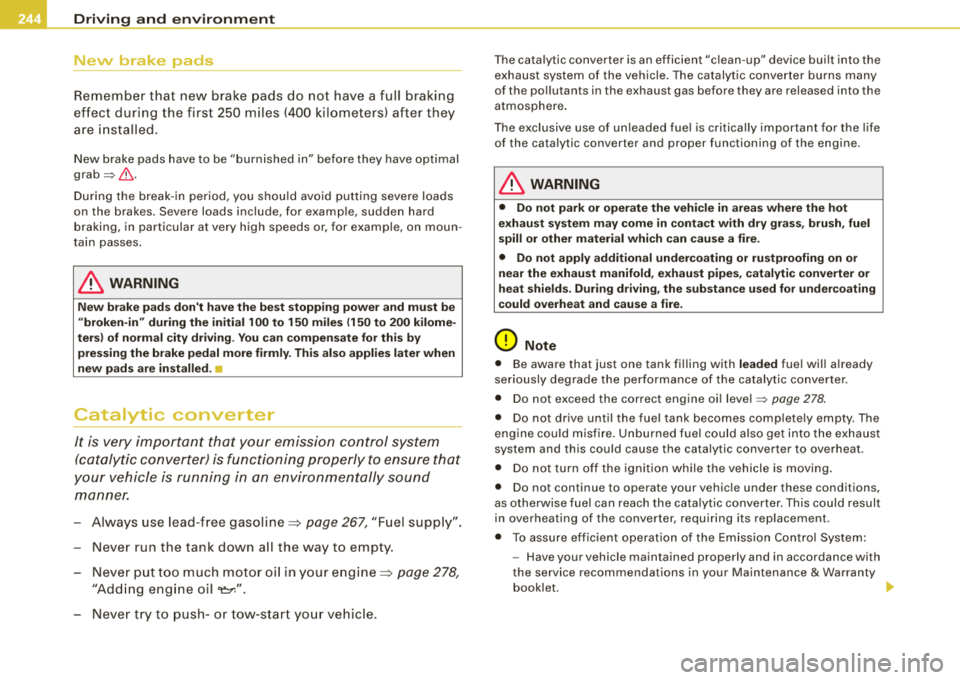
llffll.,__ __ D_r_ iv _ in_.... g,_ a_n_ d __ e_n _v_ ir_o_ n_ m_ e_n_ t _____________________________________________ _
New brake pads
Remember that new brake pads do not have a full braking
effec t during the first 250 miles (400 kilometers) after they
are i nstalled .
New brake pads have to be "burn ished in" befo re they have opti mal
grab =>& .
During the break -in period, you s hou ld avo id putti ng severe loads
on the brakes . Severe loads include, for examp le, sudden hard
braking, in particular at very h igh speeds or, for example, on moun
t ain passes .
& WARNING
New brake p ad s don't h ave th e be st sto pping p ower a nd mu st b e
" brok en -in " durin g th e initial 100 to 1 50 mil es (150 t o 200 kil ome
t e rs) of norm al cit y dri ving . You can comp en sa te for thi s by
pr ess ing the brak e ped al mor e firmly . Thi s al so appli es later when
ne w pad s a re in sta lled. •
Catalytic converter
It is very important that your emission control sys tem
(catalytic conver ter) is functioning properly to ensure that
y o ur vehicle is running in an environmentally sound
manner.
-Always use lead-free gasoline => page 267, "Fuel supply".
-Never run the tank down a ll the way to empty.
-Never put too much motor o il in your engine => page 278,
"Add ing eng ine oil
The catalytic converter is an efficient "clean-up " device built into the
exhaust system of the vehicle. The catalyt ic converter burns many
of the po llutants in the exhaust gas before they are released into the
atmosphere.
T he exc lusive use o f un leaded fue l is critica lly important for the l ife
of the catalytic converter and proper functioning of the engine.
& WARNING
• Do not park or operate th e veh icle in ar eas wh ere the hot
ex hau st sys tem m ay come in contac t w ith dr y gra ss, bru sh , fuel
s pill or other material which can cau se a fire .
• Do not appl y additi ona l under coating or ru stpr oofing on or
ne ar the e xhau st m anifol d, ex haust pipe s, ca ta lytic converter or
he at shield s. Du ring dri ving , the sub sta nce u sed f or under coating
c ould overhe at and cau se a fir e.
0 Note
• Be aware that just one tank filling with leaded fue l wi ll already
ser iously degrade the performance of the catalyt ic converter.
• Do not exceed the correct engine oi l
level=> page 278.
• Do not drive until the fuel tank becomes comp letely empty . The
engine could misfire . Unburned fuel could also get into the exhaust
system and this could cause the catalytic conver ter to overheat .
• Do not turn off the ignition wh ile the vehicle is moving.
• Do not continue to operate your vehicle under these conditions,
as otherwise fuel can reach the cata lyt ic converter . This cou ld result
in overheating of the converter, requiring its rep lacement .
• To assure eff icient operat ion of the Em iss ion Control System:
- Have your vehicle maintained properly and in accordance with
the service recommendations in your Maintenance
& Warranty
booklet.
..,
Page 247 of 368
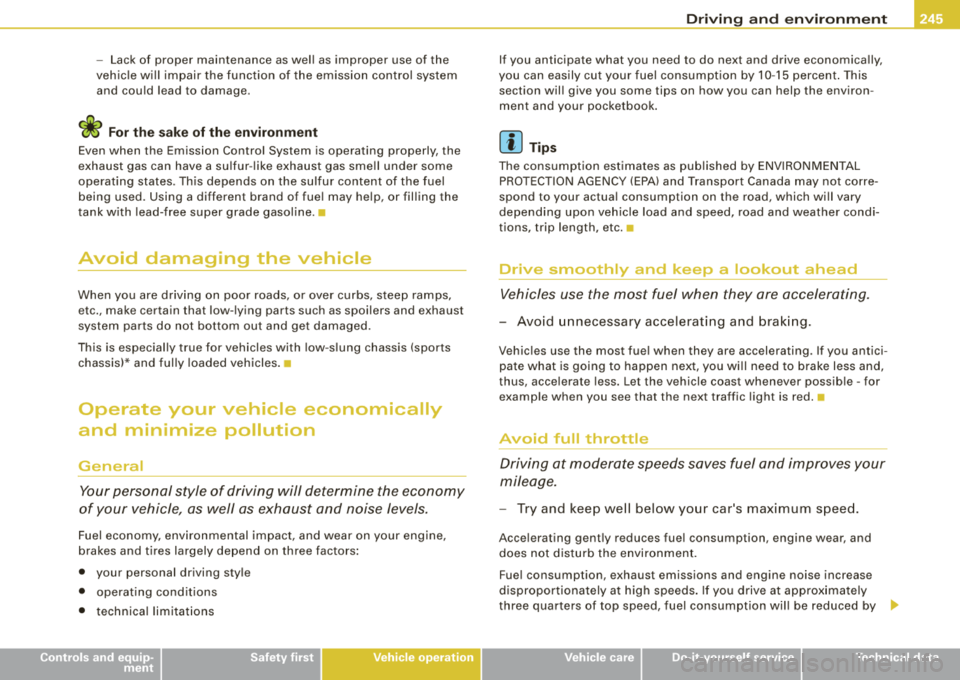
______________________________________________ D_ ri_v _ i_ n _, g..,_ a_ n_d _ e_ n_ v_i_r o_ n_m_ e_ n_t _____ ffllll
- Lack of proper maintenance as wel l as improper use of the
vehic le wi ll impair the func tion of the emission control system
and cou ld lead to damage .
<£> For the sake of the envir onm ent
Even when the Emission Control System is operating properly, the
exhaust gas can have a su lfur -like exhaust gas sme ll under some
operat ing states . Th is depends on the sulfur content of the fuel
being used. Using a different brand of fue l may he lp, or fil ling the
tank with lead -free super grade gasol ine. •
Avoid damaging the vehicle
When you are driving on poor roads, or over curbs, steep ramps,
e tc., make certain that low- lying parts such as spoilers and exhaust
system parts do not bottom out and get damaged.
This is especial ly true for vehicles with low -s lung chassis (sports
chassis)* and ful ly loaded vehicles .•
Operate your vehicle economically
and minimize pollution
General
Y o ur personal style of driving will determine the economy
of your vehicle, as well as exhaust and noise levels.
Fuel economy, env ironmental impact, and wear on your engine,
brakes and t ires largely depend on three factors :
• your personal driving sty le
• operat ing cond it ions
• technica l limitat ions
Controls and equip
ment Safety first Vehicle operation
If you anticipate what you need to do next and drive economica
lly,
you can easily cut your fuel consumptio n by 10 -15 percent . This
section wil l give you some tips on how you can help the environ
ment and your pocketboo k.
[ i ] Tips
The cons umption estimates as pub lished by ENV IRO NM EN TAL
PRO TECTION AGENCY (EPA) and Transport Canada may not corre
spond to your actua l consumption on the road, which wi ll vary
depending upon veh icle load and speed, road and weather condi
tions, trip length, etc. •
Drive smoothly and keep a lookout ahead
Vehicles use the most fuel when they ore accelerating .
-Avoid unnecess ary accelerating and brak ing.
Vehic les use the most fue l when they are accelerating . If you ant ici
pate what is going to happen ne xt, you wi ll need to brake less and,
thus , acce lerate less. Let the vehicle coast whenever poss ib le -for
examp le when you see that the next traffic light is red. •
Avoid full throttle
Driving at moderate speeds saves fuel and improves your
mileage.
- Try and keep we ll below your car 's max imum speed.
Acce lerating gent ly reduces fue l consump tion , engine wear, and
does no t disturb the environme nt.
Fue l consumption, exhaust emissions and engine noise increase
disproportionately at h ig h speeds . If you drive at approx imate ly
three quarters of top speed, fuel consumpt ion wil l be reduced by _,,,
Vehicle care Do-it-yourself service Technical data
Page 248 of 368

lffll.,__ __ D_r_ i_v _i_n _.g..,_ a_ n_d_ e_ n_v _ i
_ r_o _ n_ m_ e_ n_ t _______________________________________________ _
one half. Never drive faster than the posted speed limit and weather
conditions permit. •
Reducing unnecessary idling
Even when your car is just idling it burns up fuel.
- Shut the engine off when you are not driving the vehicle .
- Do not warm up the vehic le by letting the engine run at
id le .
It makes sense to shut off the engine in traff ic jams, when waiting
for tra ins to pass at rai lroad crossings , or at traffic lights that have
long waits on red. Turning the engine off for just 30 -40 seconds
saves more fue l than is burned starting the engine again .
It takes a long time for the engine to warm up fu lly when it is
running at idle. However, wear and noxious emiss ions are espec ially
high when the engine is warming up . So you should drive away as
soon as you sta rt the engine and avoid running at high rpms w hile
the engine is sti ll warming up.
0 Note
Do not leave engine idling unattended after starting . If warning
lights should come on to indicate improper operation, they would
go unheeded. Extended id ling also produces heat, which could
resu lt in overheating or other damage to the vehic le or other
property .•
Regular maintenance
A badly tuned engine unnecessarily wastes a lot of fuel.
- Have your ve hicle serviced at regular intervals .
By having your vehicle regularly serviced by an Audi dealer helps to
ensure that it runs properly and economical ly . The cond ition of your
vehic le not only affects its safety and abi lity to hold its value, it also
affects
fuel consumpt ion .
Check your oil ea ch time you fill your t ank .
The amount of oil used is related to engine load and speed.
I t is norma l for the oi l consumption of a new engine to reach its
lowest value after a certain mi leage has been driven.
You must drive your vehicle about 3,000 miles (5,000 kilometers) before you can properly assess oil consumption .
This also applies to fue l consump tion and engine output .
0 Note
• Have your vehicle maintained properly and in accordance with
t he service recom mendat io n s in your Maintenance
& Wa rranty
booklet. Lack of proper ma intenance as well as improper use of the
vehic le wi ll impai r the function of the emission cont rol system and
cou ld lead to damage.
• Do no t alte r or remove any component of the Emission Contro l
System unless approved by the manufacturer .
• Do not alte r or remove any dev ice, such as heat shields,
switches, ignition wires, valves, which are designed to protec t your
vehic le's Emission Control System and other important veh ic le
components .•
Fewer short trips
Fuel consumption will alw ays be rel atively high on short
t r ips.
- Try to avo id driving short dis ta n ces wi th a cold engine. ~
Page 249 of 368
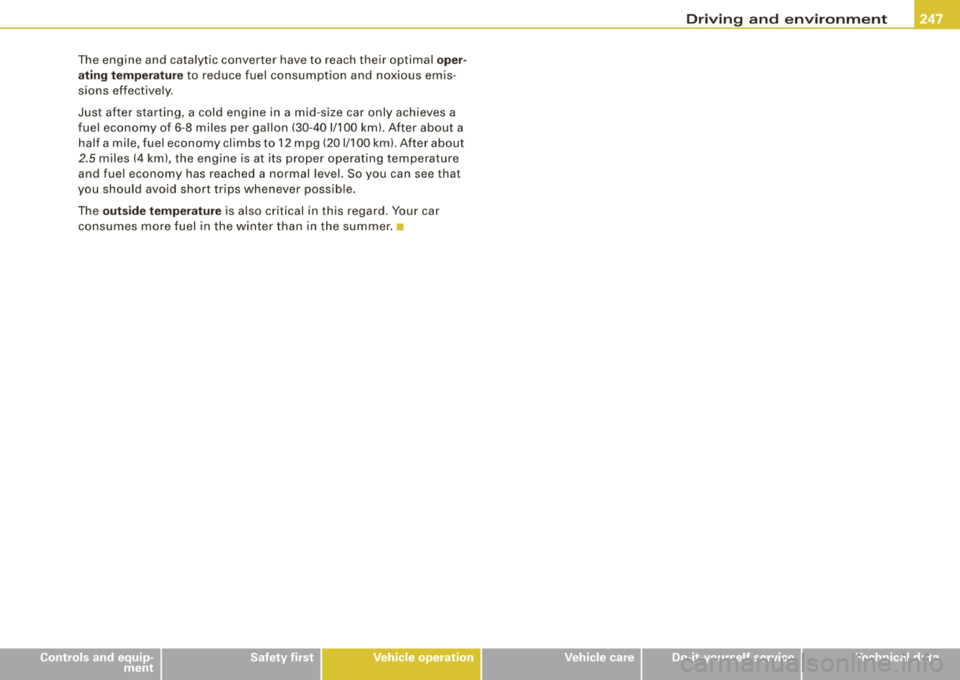
______________________________________________ D_ ri_v _ i_ n _, g..,_ a_ n_d _ e_ n_ v_i_r o_ n_m_ e_ n_t _____ ffllll
The engine and catalytic converter have to reach their optimal oper
at ing te mpera tur e to reduce fuel consumption and noxious emis
sions effective ly .
Just after starting, a cold engine in a mid -size car only achieves a
f ue l economy of 6-8 miles per ga llon (30-401/100 km). After about a
half a mile, fue l economy climbs to 12 mpg (201/100 km). After about
2.5 m iles (4 km), the engine is at its proper operat ing temperature
and fuel economy has reached a normal level. So you can see that
you should avo id short tr ips whenever poss ib le .
The outsi de te mp eratur e is also critical in this regard . Your car
consumes more fuel in the winter than in the summer. •
Controls and equip ment Safety first Vehicle operation
Vehicle care Do-it-yourself service Technical data
Page 250 of 368

lllffl.___T_ r_a _il _e_ r_ t_o _vv_ i_ n """g"'- ---------------------------------------------------
Trailer towing
Driving with a trailer
General information
Your Audi was designed primarily for passenger transpor
tation.
If you plan to tow a trailer, please remember t hat the add it ional load
wi ll affect durability, economy and performance.
Trailer towing not only p laces more stress on the veh icle, it a lso ca lls
for more concentration from the driver.
For th is reasons, always fo llow the operating and dr iving instruc
t ions provided and use common sense. •
Technical requirements
Trailer hit ch
Use a weight -carrying hitch conforming to the gross trailer weight.
The hitc h must be suitab le for your veh ic le and tra iler and must be
mounted securely on the vehicle's chassis at a technically sound
l ocation. Use only a tra iler hitch with removable bal l mount. A lways
check with the trai ler hitch manufacturer to make sure that you are
using t he correct hitch .
Do not use a bumper hit ch .
The hitch must be installed in such a way that it does not interfere
with the impact-absorb ing bumper system . No mod ifications
shou ld be made to the vehicle exhaust and brake systems. From
time to time, check that all hitch mount ing bo lts re main securely
fastened.
When you are not towing a trai ler, remove the trailer hit c h ball
mount. Th is prevents the hitch from causing damage s hou ld your
vehic le be struck from
behind ~& .
Tire pre ssure
When towing a trailer, inf late the tires of your vehic le to the cold tire
pressure listed under "Full load" on the s ticker on the right door
jamb . Inflate trai ler tires to tra iler and tire manufacturers' specifica
t ions.
Lights
T he head ligh t settings shou ld be checked with the trailer at tached
before driving off. Have the head lights adjusted as necessary so
t hat you can see t he road ahead bu t not bl ind oncom ing traffic.
Check to make sure both vehicle and trailer lights are working prop
e rly .
Engine cool ing sy stem
Towing a t railer makes the eng ine work ha rder. It is imp ortant tha t
the cooling system's performance stands up to the additiona l
strain. Make sure that the coo ling system has enoug h fluid.
Traile r br ake s
If your tra ile r i s eq uipped wi th a braki ng system, check to be s ure
that it conforms to al l regu lations .
T he tra iler hydraulic brake system must no t be direct ly connected to
the vehic le's hydrau lic brake system .
Safety chains
Be sure trailer safety chains are properly connected from the trai ler
t o the h itch on the vehicle. Leave enough s lack in t he chains to
permit turning corners. When you install safety chains, make sure
they will not drag on the road when you are driving.
T he chains shou ld cross under t he trailer tongue to prevent it from
dropping in case of separation from the hitch. _,,,